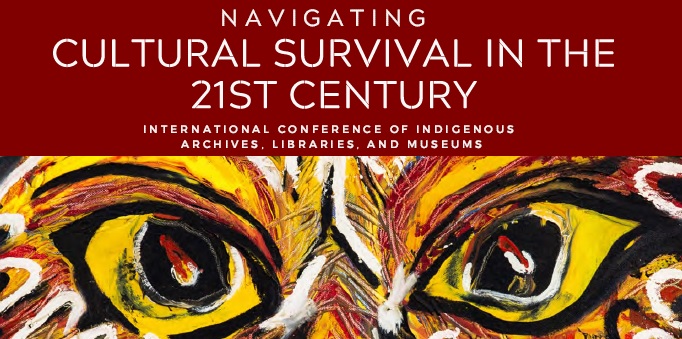Anne Ray Intern Reflects on ATALM: An Enriching Indigenous Experience

Guest post by Erin Monique Grant
I recently had the opportunity to attend the 12th Annual International Conference of Indigenous Archives, Libraries, and Museums hosted by The Association of Tribal Archives, Libraries and Museums (ATALM). The conference theme was “Navigating Cultural Survival in the 21st Century” and was held in Temecula, California, from October 8th to 10th, 2019.
ATALM was not only the first professional conference I attended, but it was an enriching Indigenous experience that I will never forget.
For me, the conference began with a pre-conference tour at the Barona Cultural Center & Museum located north of San Diego. There, I learned about the history and contemporary lives of the Kumeyaay people, which included their language, relationship to indigenous plants, and how they were one of the first tribal museums in San Diego County. My visit meant much more than simply being welcomed to the land of the Barona Kumeyaay people, it also reminded me of the historic relationship between them and my own tribe, the Colorado River Indian Tribes of western Arizona. With both of us being water people who have interacted and traded with each other in the past – I felt instantly welcomed by the end of my first day of ATALM.
The first official day of the conference began with a welcome by ATALM board chair and famed indigenous rights lawyer, Walter Echo-Hawk (Pawnee), who spoke about true tribal sovereignty and encouraging words from Pechanga Band of Luiseño Indians Tribal Chairman, Mark Macarro, who told us about his land and people of Temecula valley. The opening ceremony ended with a keynote by U.S Poet Laureate Joy Harjo (Muscogee Creek Nation) who is the first Native American to be appointed to the position. By the end of her speech, the conference ballroom was filled with people sniffling tears of pride.
Throughout the next two days of the conference, I attended sessions that further promoted the conference’s theme of “Navigating Cultural Survival in the 21st Century” but also empowered me to feel confident that I can one day assist with my own tribe’s future cultural center. One memorable event in particular was attending a session titled “Creating Collaborative Exhibitions: Interviewing and Writing with Community Members” which was hosted by Tony Chavarria (Santa Clara Pueblo) from Santa Fe’s Museum of Indian Arts & Culture/Laboratory of Anthropology. Chavarria noted that when museums allow indigenous community members to comment on their own indigenous works and art, the storytelling of the exhibition becomes more of a discussion than a lecture. I was even pulled onto stage at one point to help demonstrate an interviewing technique!

Erin Monique Grant. Photo taken during “Creating Collaborative Exhibitions: Interviewing and Writing with Community Members” Erin was pulled on stage to help demonstrate an interviewing technique. Photo courtesy of Elysia Poon.
Another intriguing panel, “Returning Home: Borrowing Objects from the Collections of the National Museum of the American Indian,” consisted of two tribal museum representatives, Lydia Four Horns of the Shakopee Mdewakanton Sioux Cultural Center and Curtis Quam from A:shiwi A:wan Museum & Heritage Center, telling listeners about the great impact the return of their cultural belongings has had on the well-being of their communities and how they shaped their cultural centers and museums.
The final session that continues to resonate with me today (as it brought me mentally back home for the one hour it was held) centered on the Huhugam Ki Museum of the Salt River Pima Maricopa Indian Community in Scottsdale, Arizona. This session was titled “Planning Indigenous Museums: Deconstructing Colonial Paradigms,” and Director Gary Owens brilliantly illustrated to us how the museum pushed forward their own Akimel O’odham and Xalychidom Piipaash narratives rather than the standard Eurocentric museum practice.
By the end of the conference, I felt proud to be indigenous. I felt proud to be Hopi, O’odham, and Mojave in a ballroom surrounded by other indigenous museum, library and archive professionals. I felt proud to be united with all of those who attended the ATALM conference as we strive to uplift our own Native communities and the entirety of Indian Country. Lastly, I felt proud to represent SAR and IARC and incredibly thankful to our institution for the opportunity to attend the ATALM conference. Askwali.
-Erin Monique Grant (Colorado River Indian Tribes), 2019-2020 Anne Ray Intern

Erin Monique Grant, 2019 Anne Ray Intern, Participating in one of the many activities for ATALM attendees. This was “Art Rush Night.”
Each year the Indian Arts Research Center at the School for Advanced Research supports two emerging museum professionals through the Anne Ray internship program. The nine-month paid internships are available to college graduates or junior museums professionals and include a salary, housing, book allowance, roundtrip travel to SAR, and a professional conference. Interns participate in the daily collections, registration, and program activities of the IARC and benefit from the mentorship of staff and resident scholars. The deadline to apply each year falls on March 1.
Learn more about the program and meet our interns here.